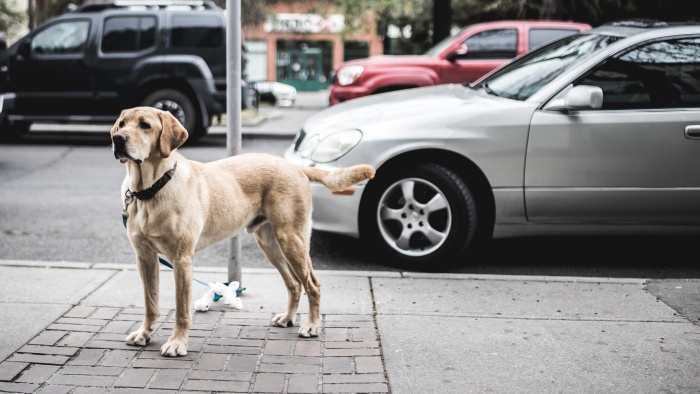How To Make Your Dog A Service Dog

“How to make your dog a service dog?” is one of the most common inquiries we receive daily at our service dog training Los Angeles facility.
There is no one-size-fits-all approach, but all service dogs, whether for psychiatric service dog training, mobility service dogs, hearing service dogs, or other types, require extensive expert training, behavior modification, and a well-suited temperament and demeanor.
When you contemplate how to make your dog a service animal, you must consider various factors, both related to your dog and your own capabilities.
Your service dog must:
- Pass a Public Access Test (PAT).
- Receive high-level obedience training.
- Exhibit impeccable behavior and manners in all environments and distractions.
- Possess the right personality, temperament, and demeanor.
- Be trained for specific tasks related to your disability.
In addition, you need to:
- Be disabled as defined by the ADA.
- Acquire extensive knowledge about dog training, behavior, health, nutrition, laws, canine ethology, psychology, cognitive ethology, evolution, physiology, neurobiology, sociology, learning theory, animal husbandry, and all things canine and service dog-related.
- Be a responsible and humane pet parent and service dog handler (pass a Canine Good Citizen test).
Service dogs, emotional support animals, therapy dogs, and all working assistance animals share common traits, including impeccable manners, behavior, obedience, and foundational training needed for their roles.

Think of service dogs as akin to Olympic athletes or top doctors in their fields. It takes years of continuous effort, dedication, and natural aptitude to reach such levels.
While there is a high failure rate and the pursuit can be costly and time-consuming, it should not discourage you from trying to make your dog a service dog. The journey can bring out the best in your dog’s training and behavior and educate you in the process.
If you understand the associated risks and believe both you and your dog have what it takes to become a successful service dog team, here is a practical service dog training guide to help you stay focused on the necessary steps.
Service dog training guide
When you’re on the hunt for a comprehensive guide on how to train a service dog, you require a manual that covers the essential skills and behaviors needed for a service dog.
Regardless of the specific type of service dog you need, all service dogs undergo rigorous training in obedience and behavior.
This guide can function as a Service Dog Training Manual or provide minimum competency guidelines. Whether you’re seeking a PTSD service dog training manual or mobility service dog training guidance, the foundational behaviors, training methods, temperament, and criteria are similar across all service dog categories.
Tasks tailored to your unique disability will be addressed in later stages of the service dog training process.
While it might be tempting to start with task training, it’s crucial not to overlook the initial public access test. If your dog cannot pass this test, they won’t be allowed to accompany you in places that restrict pets, regardless of their task-performing abilities.
Here is an overview of the numerous skills a dog needs to master (generalized, proofed, and fluent) to become a service dog:
- Sit
- Down (Lateral and Sphinx positions)
- Stand
- Heel
- Stay (in each of the above obedience positions)
All of the above commands must be executed for extended durations, in various positions, and amidst distractions like children, other dogs, cats, squirrels, and more. These commands should be followed whether you and your service dog are in motion or at rest.
Additionally, your service dog should excel in:
- Loose Leash Walking
- Leave it
- Drop it
These commands must be executed reliably even in the presence of novel stimuli and heavy distractions, both near and at a distance.
Moreover, a service dog should exhibit:
Flawless cue discrimination, responding accurately to verbal and gestural cues.
Impeccable manners in all environments and situations, showing friendliness, calmness, and confidence.
Potty training: A dog should consistently exhibit specific behaviors before being considered fully potty trained. These behaviors include eliminating when on-leash, while wearing a collar, harness, or backpack, and on cue in various settings and around other people.

Service dogs must also be proficient in:
Task training to assist with your specific disability, demonstrating attentiveness to your needs in diverse scenarios and environments.
These are some of the key skills a service dog must acquire. Equally important, however, is the handler’s understanding of dog behavior, body language, health, local laws, learning principles, gentling techniques, proper dog care, and ensuring the dog’s overall well-being—medically, nutritionally, physically, emotionally, and cognitively.
Each of the above skills must be performed in various ways and environments. A Certified Service Dog Trainer will provide detailed explanations and training for each skill as you progress through the training program.
A Public Access Test (PAT) is a critical milestone that deserves its own discussion. In brief, during a PAT, a service dog must thrive in all aspects of life, indoors and outdoors, in urban, suburban, and rural settings.
For instance, in Los Angeles, California, training should encompass locations such as downtown Los Angeles, Beverly Hills, and Pacific Palisades. Dog training cannot be limited to your immediate neighborhood.
Service dog temperament, personality, and demeanor
What qualities define an ideal service dog? It’s crucial to recognize that these attributes can vary among individual dogs, and we must always consider the well-being and rights of these sentient beings, ensuring they remain happy and free to enjoy the five freedoms.
While obedience training for task performance is a vital part of service dog training, it represents only a portion of the overall process. To truly become a service dog, a canine companion must possess a Goldilocks temperament, personality, demeanor, and genetics that align with the demands of the work they will be performing.
Furthermore, a dog’s physical characteristics, including morphology and, to some extent, breed, should match the specific tasks they will assist with. For instance, a Saint Bernard might not be suitable for PTSD service dog training if the goal is to apply tactile pressure to a person’s body, as their size could potentially cause harm.
Conversely, a Chihuahua or other small breed may not effectively stabilize someone who requires support while walking or has a disability where the dog’s size is a critical factor.
In addition to the obvious qualities, here are additional temperaments, personalities, and demeanors that are essential for a service dog or working animal:
Desirable qualities of a service dog
- An aloof manner towards external stimuli while remaining focused and attentive when working.
- Exhibiting a composed and confident demeanor in all environments and around various stimuli.
- Being gentle and tolerant when interacting with strangers, including being petted by children and other individuals, without displaying fear, anxiety, or stress.
- Demonstrating an easy-going and energetic nature, enjoying walks and embracing new environments and adventures with enthusiasm.
- Eagerness to please and a strong desire to work, being sensitive to the handler’s needs.
- Forming a strong bond and connection with the handler, showing a preference for the handler over others, and consistently checking in and being attuned to their needs.
- Ignoring other people and animals.
- Responding positively to gentling and husbandry procedures, finding them enjoyable and stress-free, allowing handling and touching in all situations.
A service dog should not possess or display
- Excessive friendliness, where the dog constantly seeks attention from others, potentially diverting focus from the handler.
- Reactivity or impulsiveness towards anything or anyone, whether it’s food on the floor, squirrels, other dogs, or children running by.
- Aggression towards anything or anyone, including dogs, cats, squirrels, or people.
- Territorial aggression.
- Fear aggression.
- Dominance aggression.
- Being too young or too old, with the typical working years for a service dog falling between 2 to 7 years.
- Behavioral disorders, quirks, or anxieties, as anxiety is incompatible with service dog training and work.
- Prey drive, which involves chasing, lunging at, or barking at animals or people.
- Resource guarding.
- Protective or guard dog tendencies.
- Demanding attention through behaviors like barking, jumping, pawing, and temper tantrums.
- Soliciting attention by staring at people or dogs and approaching them for interaction.
- Being responsive only when bribed, intimidated, yelled at, or forced to comply with cues or behaviors.
- Being trained with aversive or punitive equipment, such as electric collars, choke chains, or prong collars, which are inhumane and unacceptable.
- Remaining unaltered, as the majority of service dogs are spayed or neutered, although not required by all laws, it is a standard practice in reputable service dog training.
- Displaying aggressive behaviors like lunging, biting, growling, or snarling.
If your dog exhibits any of the aforementioned issues, consulting with a Certified Dog Behaviorist is advisable to assess severity, provide a proper diagnosis, establish realistic expectations, and determine the potential for your dog to become a service dog.
In any case, a dog with behavior or training issues will likely require extensive training and behavior modification to become a service dog. Even dogs without significant issues need hundreds of hours of professional dog training from an experienced service dog trainer.
Why service dogs don’t succeed
Remember the analogy to the Olympics? Well, it still holds true. On average, fewer than 25% of dogs successfully become service dogs, even when their handlers invest an extensive amount of resources and commit to rigorous, dedicated, and painstaking training and behavior modification efforts.
Even among the elite group of seeing-eye dogs, which are meticulously bred for service dog roles through highly controlled breeding programs with stringent criteria for lineage, genetics, traits, personalities, demeanor, health, and more, approximately 50% ultimately do not graduate to become service dogs.
The reasons behind this high failure rate among service dogs can typically be categorized into three main areas:
Health: This encompasses a range of mental, physical, cognitive, biological, and emotional “defects.” These issues can include conditions affecting the hips, elbows, eyes, ears, thyroid, heart, dermatitis, separation anxiety disorder, general anxiety, and more.
Behavior and Training Deficiencies: Some dogs may exhibit training challenges and behavior issues that hinder their ability to perform service dog tasks effectively. These issues may include being too easily aroused, easily scared, overly excited, lacking resiliency, having difficulties with emotional regulation, slow learning, poor retention of training, and more.
Temperament, Demeanor, and Personality “Defects”: Service dogs need to possess specific temperament traits, personalities, and demeanors to excel in their roles. Some dogs may not display the desired characteristics, such as a lack of interest in work, insufficient energy levels, inability to stay focused, a strong need for social interaction and play, excessive startle responses, excessive confidence, over-sensitivity, frequent distractions, not calm, or a general lack of focus and engagement.
In the challenging journey of training service dogs, these factors often come into play, contributing to the significant failure rate observed in the service dog community.
Service dog certification and registration
Every day, we receive inquiries about service dog certification, how to obtain a service dog certificate, training a dog to become a service dog for travel purposes, and even acquiring a service dog vest.
The good news is that federal laws intentionally allow knowledgeable and experienced individuals to train their own service dogs.
The not-so-good news? Successfully training a service dog requires an extensive understanding of canine ethology, cognitive ethology, learning theory, animal husbandry, gentling techniques, mechanics of dog training, body language, biology, nutrition, behavior, and training.
So, what exactly is a service dog certification or certificate? When it comes to obtaining service dog certification or service dog certificates, there’s more to it than simply ordering one online or purchasing them from a company that offers questionable doctor’s letters, certificates, vests, or registrations.
Here’s the important part: NONE of these mentioned items are legally required under federal law or the Americans with Disabilities Act (ADA). Yes, that’s correct—federal law does not mandate service dog certification, registration, licensing, vests, or any other similar documents. While local city or state laws may vary, federal laws usually take precedence.
If federal law doesn’t require service dog registration or certification, what should you do?
First and foremost, understand that your dog’s BEHAVIOR matters most. When businesses assess whether your dog is a legitimate service dog or a potential fraud, your dog’s behavior is the primary criterion. Whether you have a disability, a doctor’s letter, a service dog training vest, a harness, or any equipment is secondary.
“Under the ADA, it is training that distinguishes a service animal from other animals.”
If your dog’s behavior doesn’t align with that of a service dog, any business has the right to ask you to leave or even pursue legal action.
Service dog certification is NOT REQUIRED, but your dog’s behavior must be exemplary!
It’s worth reiterating: Federal law does not necessitate certification or registration for a service dog to accompany you in places where pets are typically not allowed.
The government intentionally left this loophole to enable individuals with limited resources to train their own service dogs. Consequently, there are no licensed service dog trainers or mandatory certifications.
Interestingly, in Los Angeles and similar locations, I still provide clients with service dog certifications/certificates because it can ease the experience for individuals with disabilities when flying or being in public. However, legally speaking, these certificates are unnecessary, despite the numerous online businesses attempting to sell them.
So, don’t waste your money on service dog certification, registration, or doctor’s letters claiming you have a disability if your dog lacks the required training to be a legitimate service dog. Instead, invest in proper dog training and behavior work to ensure your dog is genuinely qualified to be a service dog.
PAT
By now, you’ve likely encountered plenty of information about the crucial service dog training public access test (PAT) and its pivotal role in your service dog training journey. Let’s delve into the fundamentals of what the PAT entails.
In essence, a PAT is a comprehensive evaluation that assesses your dog’s behavior, training, temperament, demeanor, and personality in various real-world scenarios—situations beyond the confines of your home or immediate neighborhood.
Moreover, the PAT also serves as a gauge of your ability to effectively handle your service dog and measures your knowledge about service dogs and their appropriate behavior in public settings.
To successfully pass a PAT, a service dog must demonstrate its capability to navigate public places or vehicles safely and efficiently while remaining under the control of its primary handler.
While some 501(c)(3) organizations offer PAT guidelines to assist handlers throughout the training process, it’s crucial to recognize that even these guidelines and all standard tests may not cover every unique situation you’ll encounter with your dog in your daily life. Therefore, it’s advisable to view these PATs as a foundational starting point and be ready to adapt and expand upon them to suit your specific lifestyle and needs.
Remember, these PATs represent the minimum standards that a service dog should be familiar with, but your dog’s training should extend beyond these basics to ensure their proficiency and reliability in diverse real-world situations.
SDIT
Understanding what a service dog in training (SDIT) is constitutes a pivotal aspect of the process of turning your dog into a service dog, whether you are a certified service dog trainer or an individual training your own service dog. Familiarity with these laws is paramount.
In essence, service dog-in-training laws serve to extend the legal provisions of the Americans with Disabilities Act (ADA) to cover non-service dogs that are undergoing training to become service dogs.
Whether you are a professional service dog trainer or a person with a disability embarking on the journey of training your service dog, it is imperative to grasp and adhere to these laws. Failure to do so can hinder the effective training of a service dog.
To be effective in working with your SDIT, you must acquaint yourself with the specific laws pertaining to service dogs in training in your location, be it Los Angeles or anywhere else in the world.
Why are these laws so crucial? Well, without them, your SDIT would be unable to undergo the essential and extensive training required in public settings where pets are typically not allowed. The absence of these legal allowances would severely hinder the path to becoming a service dog.
While the regulations may vary from one state to another, service dogs in training generally enjoy the same legal rights as fully trained service dogs when it comes to accessing areas where pets are typically prohibited.
In Los Angeles, California, for instance, service dog trainers are mandated to register each service dog in training with Los Angeles County Animal Control. This involves completing an application that verifies you as a service dog trainer, which includes having a registered business with the SOS and the FTB in good standing or being a parent with a disability. A fee is also required to mark the dog as a service dog in training, granting a license to bring the SDIT to locations like restaurants, beaches, parks, stores, airplanes, and other public areas where fully trained service dogs are legally permitted.
These laws are essential for the success of service dog training. They empower professional service dog trainers and individuals with disabilities to conduct training in public spaces where ordinary pets are not allowed. In some cases, certain animal control officials may even refund the fee for a temporary service dog license when the dog leaves the trainer’s care and is placed with a family, particularly in areas within greater Los Angeles.
It’s important to note that if you are a parent training your own service dog, you will not receive a refund for the fee. Instead, you will need to ensure that your dog is licensed and registered as a service dog in Los Angeles, regardless of whether they are in training or a fully trained service dog.
However, the specifics of these laws can vary from one city to another, so thorough research of your local animal control laws is essential before commencing your service dog training journey. Staying informed about the relevant laws at the state and county levels is crucial, and resources like Michigan State University’s Animal Legal and Historical Center’s table of state service animal laws can be immensely helpful in this regard.

Mental health and emotional needs of service dogs
In addition to their extensive training and skills, the mental health and emotional well-being of service dogs are paramount. These dogs are not mere tools but sentient beings with emotional needs.
Ensuring their psychological health involves regular mental stimulation, love, playtime, and rest.
Service dogs require a balanced life with opportunities for relaxation and enjoyment. It’s crucial to recognize and respect their limits, providing a nurturing environment that fosters both their physical and emotional well-being. This holistic approach contributes significantly to their effectiveness and longevity as service dogs.
Conclusion
The journey of making your dog a service dog is intricate and demanding, encompassing a wide spectrum of training, behavior, health, legal, and ethical considerations. From mastering obedience commands and passing the Public Access Test to understanding the nuances of canine psychology and local laws, every step plays a crucial role in this transformative process.
It’s a path that demands dedication, patience, and a deep understanding of both your dog’s and your own capabilities. Importantly, alongside the rigorous training, the mental health and emotional needs of your dog must not be overlooked.
Providing a nurturing and balanced environment is vital for their overall well-being. Remember, “How to make your dog a service dog” is more than just a question; it’s a commitment to a journey that, when navigated with care and knowledge, can lead to a rewarding partnership between you and your canine companion.
FAQs
What Should I First Consider When Deciding to Train My Dog as a Service Dog?
Before beginning the training process, consider if your dog has the appropriate temperament and health for service work. Assess their ability to remain calm in various environments, their reaction to distractions, and their overall physical and mental health. This initial assessment is crucial in determining their suitability for the demanding role of a service dog.
How Long Does Service Dog Training Typically Take?
Training a service dog is a time-intensive process that can take several months to over a year, depending on the dog’s existing training level and the specific tasks they need to learn. Consistent, daily training sessions are essential for success. The duration also depends on whether you’re training the dog yourself or seeking professional help.
Can I Train My Service Dog Myself or Do I Need a Professional Trainer?
While you can train your service dog, it requires a thorough understanding of dog training techniques and service dog requirements. If you’re new to dog training or the specifics of service dog training, seeking the guidance of a professional trainer, especially for advanced tasks and behaviors, is advisable.
Are There Any Specific Breeds That Are More Suited to Being Service Dogs?
While no specific breed is exclusively suited for service work, some breeds are more predisposed to the qualities needed in a service dog, such as Labrador Retrievers, Golden Retrievers, and German Shepherds. However, individual temperament and health are more important factors than breeding.
What Happens If My Dog Fails the Public Access Test (PAT)?
If your dog fails the PAT, it’s an indication that more training is needed. Analyze the areas where your dog struggled and focus on improving those skills. You can retake the PAT after additional training, ensuring your dog is better prepared for the test’s requirements.
Here is our carefully selected video of training a dog to become a service dog:

